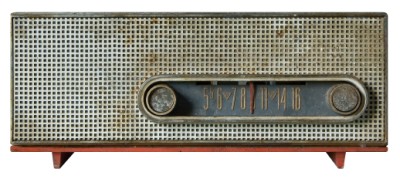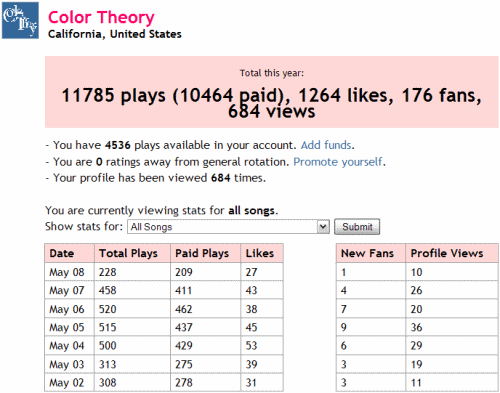
My last article on Jango sparked spirited discussions on the Just Plain Folks and CD Baby forums, and in the comments. Words like “scam” and “payola” are recklessly thrown about. We need to dispel these unfair and inflammatory accusations before we can have an honest debate.
Is it a scam?
Absolutely not! It is a service that delivers everything it promises. Jango sells airplay, not results. To put it in perspective, I’ve spent nearly $4,000 on Taxi since becoming a member in 1997. I’ve had over 100 forwards, but no deals. I’ve spent $7,000 on traditional radio promotion, with literally nothing to show for it. That doesn’t mean that Taxi and traditional radio promotion are scams. They just haven’t been effective (YMMV).
Is it payola?
Traditionally speaking, payola is the illegal payment for over-the-air broadcast of songs as regular airplay. The term simply doesn’t apply. Jango is not regulated by the FCC, and is not breaking any laws.
In a more general sense, the word has come to refer to any secret payment made to cast a product in a positive light. That’s not the case either. Paid plays are distinct from regular plays. The site opens a pop-up asking for feedback in the form of a rating, comment, or becoming a fan. There’s an ad for the Jango Airplay program right in the header!
Is it immoral?
No, because no deception is taking place. The system is transparent. Artists pay for advertisement, the same way traditional advertisers buy slots on TV and traditional radio.
Now that that’s out of the way, let’s address the more compelling argument, which goes something like this:
Airplay should be based on merit alone. If an artist’s work is good enough, it should be played for free. If it isn’t, it shouldn’t be played no matter how much money is thrown behind it. By legitimizing pay-for-play, we devalue art and ruin the listening experience.
First off, my music does get played for free. When a listener visits the site, they’re asked to “enter any artist and click play.” If they enter “Color Theory,” they’ll hear my music, and I won’t have to pay for it. The airplay program allows me to buy extra plays, so that if they enter “Depeche Mode,” they may still end up hearing my music.
Some argue that Jango should simply accept submissions and play the best of what they receive. Before the airplay program started, they did (I sent them my latest, but never heard anything back). The problem is that screening the material costs the company money, which results in more interruptive traditional ads. Assuming that listeners would rather hear quality indie songs than traditional ads, the airplay program provides a better listening experience.
Quality control is key. All songs must be approved by the staff before entering paid rotation. If a song gets more negative than positive ratings, it gets “retired” (and the unused plays refunded). New users will only hear one airplay song per day max. Regular users will hear up to one airplay song per hour on average, unless they opt in for more.
Is it effective?
For many, this is the only question worth asking. Here are my stats at a little over $200 into my $300 campaign:

You can see by comparing “total plays” to “paid plays” that I’m getting a good number of unpaid plays, which will continue after my campaign ends. The numbers look good, but how do they translate into measurable results like sales and mailing list signups? The honest answer is, I don’t know.
One listener bought a CD and t-shirt from me directly, but most sales probably go through iTunes and Amazon via the “buy” button built into the player. My Amazon sales are up, but I’ve got a lot of balls in the air right now, so I can’t necessarily attribute that to Jango. I won’t know about digital sales until they’re reported to CD Baby.
A label owner friend of mine was targeting electronic and dance bands, but discovered through Jango’s fan overlap report that Britney Spears fans love the band he’s promoting. He changed his targets and saw a huge spike in Amazon sales. So at least there are some anecdotal success stories.
As for mailing list signups, I can’t trace any to Jango. While I can message my fans through the site, both individually and collectively, I can’t send them an actual e-mail. As an experiment, I sent out a bulletin entitled “does anyone read these bulletins?” to 170 fans, requesting a simple acknowledgment. Three people responded.
Obviously Jango can’t afford to litter the site with MySpace-style band ads, or force their listeners to respond to messages. They need to maintain a compelling listening experience with as few interruptions and distractions as possible. Still, a few unintrusive tweaks would go a long way towards helping artists measure the results of their paid campaigns:
- Track clickthroughs and open rates. How many people clicked the “buy” button as my song played? How many people actually read my bulletin? At least I’d know whether or not listeners were considering buying my music.
- Allow direct communication with fans by e-mail. When a listener chooses to become a fan, present them with the option to “allow this artist to communicate with me directly.” Let listeners opt out sitewide, and they won’t see the checkbox again. Deliver our messages and bulletins through e-mail (keeping the address hidden for privacy reasons), or send an e-mail notification. At the very least, e-mail a weekly iLike-style digest of artist bulletins. One way or the other, just give me a reliable way to communicate with my fans.
- Place a prominent opt-in link on my profile. Give listeners more than one chance to decide. If they already agreed to direct communications, the option to opt out should be presented instead.
I’ll continue to report back with my results over time. If you are considering trying Jango Airplay, please use my affiliate link. Any money earned will be used to buy more plays for my songs.
Brian Hazard is a recording artist with fifteen years of experience promoting his seven Color Theory albums. His Passive Promotion blog emphasizes “set it and forget it” methods of music promotion. Brian is also the head mastering engineer and owner of Resonance Mastering in Huntington Beach, California.